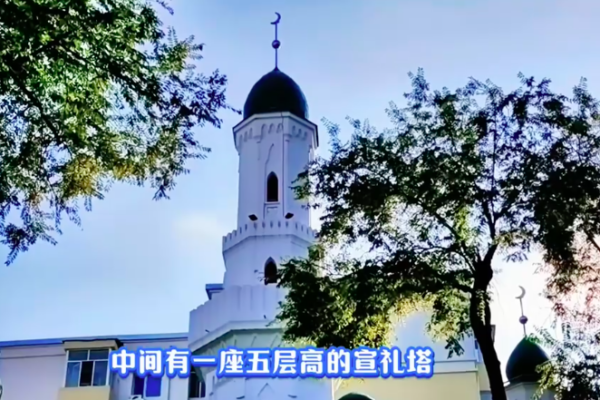In Harbin, Heilongjiang Province, a historic mosque recently underwent forced renovations by the authorities. The mosque, known for its Islamic features such as the green dome and minaret, was demolished, and the roof was reconstructed in a traditional Chinese garden style, sparking dissatisfaction and concern among the Muslim community. Public opinion widely believes that this event is the latest manifestation of the Chinese Communist Party’s vigorous promotion of “sinicization of religion” policy in recent years.
A leaked internal notice attributed to the “Daowai Mosque Management Committee” in Harbin surfaced on June 13 and spread overseas three days later. The notice specified that starting from June 16, the mosque would be taken over by construction units, using large cranes to remove the minaret. The police took over security, and worshippers were prohibited from entering. The notice urged Muslims to “pray at home or transfer to other mosques” to “ensure safety.”
The Daowai Mosque, also known as the “Tatar Mosque,” located at 108 Tongjiang Street in Daoli District, was established by Tatar Muslims from Russia in 1901. It is one of the earliest mosques in Harbin and a cultural heritage site of the history of East Asian Tatar settlements. The mosque blends Byzantine and Arab architectural styles, with its green dome and minaret being iconic features, making it one of the few well-preserved mosques in the northeastern region. In recent years, the mosque has been listed as a provincial-level cultural relic protection unit in Heilongjiang Province.
However, several residents pointed out that the mosque had undergone renovation without any public announcement. The dome and minaret disappeared, and the entire building now exhibits a typical Chinese architectural style with flying eaves. Attempts by reporters to contact the Harbin Ethnic and Religious Affairs Bureau were met with refusal to comment upon learning of the media’s identity.
An anonymous elderly Muslim from Harbin told Epoch Times, “These domes and minarets are not just buildings but symbols of our faith. Now that they have been completely removed, we have no channel to express our opinions.” He expressed that instances of domes being demolished in mosques in Xinjiang, Ningxia, Gansu, and other places were not uncommon, but Harbin had always preserved its traditional appearance. “This is the first time we have seen a mosque here transforming into something resembling a temple.”
The renovation project has also affected the naming of urban public spaces. The original “Arab Plaza Station” bus stop sign has been recently renamed to “Mosque Plaza Station.” Local Muslims privately discuss that “Even the words ‘Arab’ are no longer allowed to be used, what more can we say?”
Mr. Ma, a Muslim from Linxia, Gansu, told Epoch Times, “Since 2019, mosques in places like Gansu, Ningxia, Liaoning, Yunnan, and Heilongjiang have been gradually demolishing domes and minarets, replacing them with Chinese-style roofs resembling temples. This is to de-Arabize, even our faith is required to be localized.”
“These types of renovations are one of the practical ways of ‘sinicization of religion,'” said independent scholar Cindy (pseudonym) who studies Chinese religious policies. “The authorities consider the architectural style of Muslims as ‘foreign influence,’ and dismantling the domes is symbolically cutting off Muslim religious identity.” She pointed out that not only mosques are required to remove domes and de-Arabize, but churches’ crosses and Gothic spires have also been forcibly removed and replaced with “national style” elements like Chinese tile eaves and dragon-phoenix carvings.
In recent years, Chinese official propaganda frequently mentions concepts like “Islamic panification,” “Saudi-ization,” and “Arabization,” intending to limit the visibility of Islamic culture in public spaces. Several mosque renovation incidents have sparked community backlash, such as in April 2019, when the removal of the dome at Gaozhuang Mosque in Zheqiao Town, Linxia City, Gansu, triggered protests among worshippers. In May 2023, the renovation of the Najiaying Mosque in Tonghai, Yunnan, into an antique tower style also led to collective dissatisfaction.
Cindy emphasized that the government packages these renovations as “ethnic fusion” or “protection of local culture,” but many members of religious groups privately see it as “cultural hollowing out” and “symbolic castration,” stating, “Architectural style is not just decoration; it is the husk of identity. Removing the domes of mosques signifies the systematic erasure of a group’s presence.”
According to public records, the Harbin Tatar Mosque, located at Tongjiang Street in Daoli District, was initiated by Tatar Muslims from Russia in 1901, completed in 1906, and expanded in 1922 to commemorate a thousand years of Islamic belief. The mosque combines Eastern and Western architectural styles, with its red-and-white walls, green dome, and minaret once constituting part of Harbin’s urban landscape.

